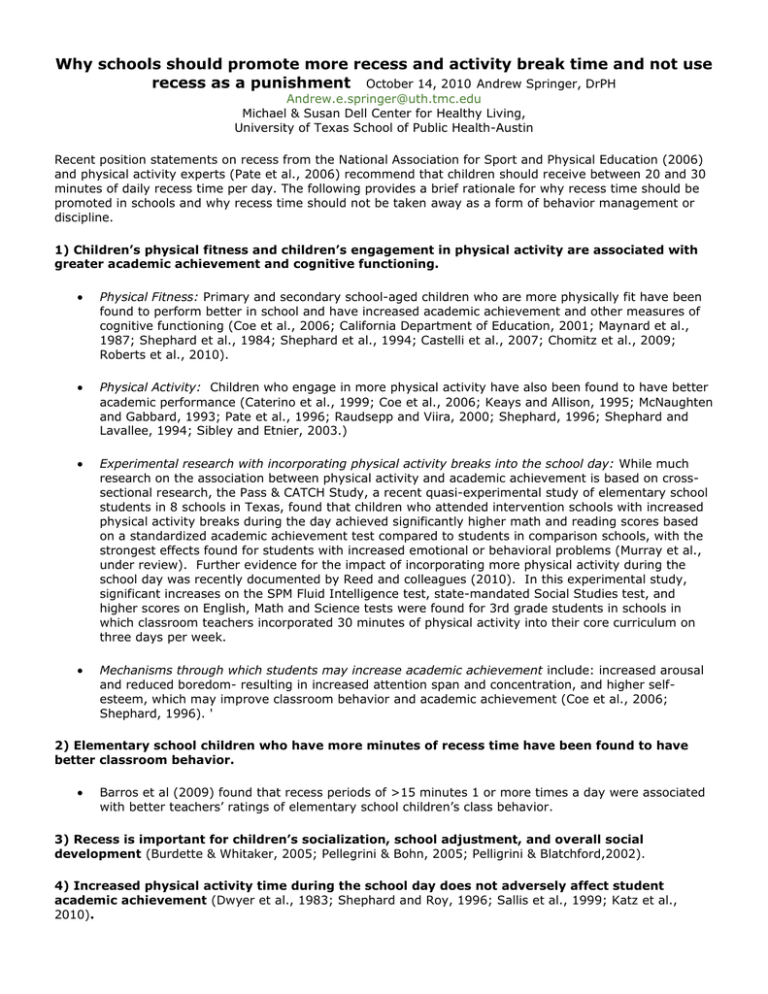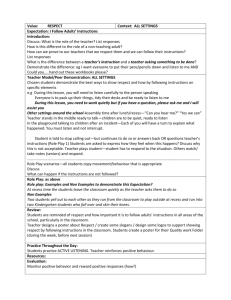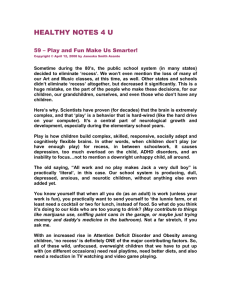1 - thenewPE
advertisement

Why schools should promote more recess and activity break time and not use recess as a punishment October 14, 2010 Andrew Springer, DrPH Andrew.e.springer@uth.tmc.edu Michael & Susan Dell Center for Healthy Living, University of Texas School of Public Health-Austin Recent position statements on recess from the National Association for Sport and Physical Education (2006) and physical activity experts (Pate et al., 2006) recommend that children should receive between 20 and 30 minutes of daily recess time per day. The following provides a brief rationale for why recess time should be promoted in schools and why recess time should not be taken away as a form of behavior management or discipline. 1) Children’s physical fitness and children’s engagement in physical activity are associated with greater academic achievement and cognitive functioning. Physical Fitness: Primary and secondary school-aged children who are more physically fit have been found to perform better in school and have increased academic achievement and other measures of cognitive functioning (Coe et al., 2006; California Department of Education, 2001; Maynard et al., 1987; Shephard et al., 1984; Shephard et al., 1994; Castelli et al., 2007; Chomitz et al., 2009; Roberts et al., 2010). Physical Activity: Children who engage in more physical activity have also been found to have better academic performance (Caterino et al., 1999; Coe et al., 2006; Keays and Allison, 1995; McNaughten and Gabbard, 1993; Pate et al., 1996; Raudsepp and Viira, 2000; Shephard, 1996; Shephard and Lavallee, 1994; Sibley and Etnier, 2003.) Experimental research with incorporating physical activity breaks into the school day: While much research on the association between physical activity and academic achievement is based on crosssectional research, the Pass & CATCH Study, a recent quasi-experimental study of elementary school students in 8 schools in Texas, found that children who attended intervention schools with increased physical activity breaks during the day achieved significantly higher math and reading scores based on a standardized academic achievement test compared to students in comparison schools, with the strongest effects found for students with increased emotional or behavioral problems (Murray et al., under review). Further evidence for the impact of incorporating more physical activity during the school day was recently documented by Reed and colleagues (2010). In this experimental study, significant increases on the SPM Fluid Intelligence test, state-mandated Social Studies test, and higher scores on English, Math and Science tests were found for 3rd grade students in schools in which classroom teachers incorporated 30 minutes of physical activity into their core curriculum on three days per week. Mechanisms through which students may increase academic achievement include: increased arousal and reduced boredom- resulting in increased attention span and concentration, and higher selfesteem, which may improve classroom behavior and academic achievement (Coe et al., 2006; Shephard, 1996). ' 2) Elementary school children who have more minutes of recess time have been found to have better classroom behavior. Barros et al (2009) found that recess periods of >15 minutes 1 or more times a day were associated with better teachers’ ratings of elementary school children’s class behavior. 3) Recess is important for children’s socialization, school adjustment, and overall social development (Burdette & Whitaker, 2005; Pellegrini & Bohn, 2005; Pelligrini & Blatchford,2002). 4) Increased physical activity time during the school day does not adversely affect student academic achievement (Dwyer et al., 1983; Shephard and Roy, 1996; Sallis et al., 1999; Katz et al., 2010). 5) Children who engage in more physical activity have better physical and mental health. Children’s participation in regular physical activity is associated with improved cardiovascular and musculoskeletal health, better mental health and emotional well-being outcomes, and prevention of chronic diseases such as obesity, hypertension and type 2 diabetes (Institute of Medicine, 2005; USDHHS, 1996). Research on 3rd grade students in Missouri found that children in intervention schools where physical activity breaks were incorporated reported lower medication use for asthma and attention-deficit disorder. Children in the intervention group were also found to have significant increases in physical fitness. (Katz et al., 2010). 6) Establishment of an active lifestyle in childhood leads to a more active lifestyle in adulthood. A large body of evidence indicates that children tend to become less physically active as they move through adolescence (USDHHS, 1996; McMurray et al., 2003; Kelder et al., 1994; Kimm et al., 2002). Despite this well documented decline, physical activity has also been found to track from childhood to adulthood (Malina, 1996; Telama et al., 2005), suggesting that the establishment of an active lifestyle early in children may reap benefits for an active lifestyle later in life 7) Physical activity may provide other benefits to children’s positive development. Physical activity participation in adolescent girls- not limited to sports team participation- is protective against sexual risk taking, including early sexual onset, failure to use birth control, and teenage pregnancy (Miller et al., 2002). Based on data from the National Longitudinal Study of Adolescent Health, obese girls are half as likely to attend college as their normal weight peers (Crosnoe, 2007). REFERENCES Barros RM, Silver EJ, Stein REK. School recess and group classroom behavior. Pediatrics Pediatrics 2009;123:431–436. Burdette HL, Whitaker RC. Resurrecting free play in young children. Arch Pediatr Adolesc Med. 2005; 159: 46-50. California Department of Education (CDE). (2001). California physical fitness test: Report to the governor and legislature. Sacramento, CA: California Department of Education Standards and Assessment Division. Castelli DM, Hillman CH, Buck SM, Erwin HE. Physical Fitness and Academic Achievement inThird- and Fifth-Grade Students. Journal of Sport & Exercise Psychology, 2007, 29, 239-252 Caterino, M. C., and E. D. Polak. Effects of two types of activity on the performance of second-, third-, and fourth-grade students on a test of concentration. Percept. Mot. Skills 89:245–248, 1999. Chomitz VR, Slining MM, McGowan RJ, Mitchell SE, Dawson GF, Hacker KA. Is there a relationship between physical fitness and academic achievement? Positive results from public school children in the northeastern United States. J of School Health 2009; 79(1): 30-37. Coe, D.P., Pivarnik, J.M., Womack, C.J., Reeves, M.J., & Malina, R.M. (2006). Effect of physical education and activity levels on academic achievement in children. Medicine and Science in Sports and Exercise, 38, 1515-1519. Crosnoe R. Gender, obesity and education. Sociology of Education 2007 (July). Dwyer T, Coonan WE, Leitch DR, Hetzel BS, Baghurst RA., An investigation of the effects of daily physical activity on the health of primary school students in South Australia, Int J Epidemiol., 1983 Sep;12(3):30813. Institute of Medicine: Koplan JP, Liverman CT, Kraak VI, eds: Preventing childhood obesity: health in the balance. Washington, DC: Institute of Medicine (U.S.); 2005. Katz DL, Cushman D, Reynolds J, Njike V, Treu JA, Walker J, Smith E, Katz C. Putting physical activity where it fits in the school day: preliminary results of the ABC (Activity Bursts in the Classroom) for Fitness Program. Preventing Chronic Disease 2010; 7(4): 1-10. Keays, J. J., and K. R. Allison. The effects of regular moderate to vigorous physical activity on student outcomes: a review. Can.J. Public Health 86:62–66, 1995. Kelder SH, Perry CL, Klepp KI, Lytle LL Longitudinal tracking of adolescent smoking, physical activity, and food choice behaviors. American Journal of Public Health, Vol 84, Issue 7 1121-1126 Malina, R.M. Tracking of physical activity and fitness across the lifespan. Research Quarterly for Exercise and Sport 1996; 67 (suppl):48-57. Maynard, E.J., Coonan, W.E., Worsley, A., Dwyer, T., & Baghurst, P.A. (1987). The development of the lifestyle education program in Australia. In B.S. Hetzel & G.S. Berenson (Eds.), Cardiovascular risk factors in children: Epidemiology and prevention (pp. 123149). Amsterdam: Elsevier. McMurray RG, Harrell JS, Bangdiwala SI, Hu J. Tracking of physical activity and aerobic power from childhood through adolescence. Med Sci Sports Exerc 2003; 35(11): 1914-1922. McNaughten D, Gabbard C. Physical exertion and immediate mental performance in sixth-grade children. Percept. Mot. Skills 1993; 77:1155–1159. Miller KE, Barnes GM, Melnick MJ, Sabo DF, Farrell MP. Gender and Racial/Ethnic Differences in Predicting Adolescent Sexual Risk: Athletic Participation versus Exercise. Journal of Health and Social Behavior 2002; 43: 436-450. Murray N, et al. Pass & CATCH. University of Texas School of Public Health-Houston. (under review). National Association for Sport and Physical Education. Recess for elementary school students [position paper]. Reston, VA: National Association for Sport and Physical Education; 2006. Pate RR, Davis MG, Robinson T, et al. Promoting physical activity in children and youth: a leadership role for schools. Circulation 2006; 114: 1214-1224. Pate RR, Heath GW, DOWDA M, and Trost SG. Associations between physical activity and other health behaviors in a representative sample of US adolescents. Am. J. Public Health 1996; 86:1577–1581. Pellegrini AD, Bohn CM. The role of recess in children’s cognitive performance and school adjustment. Educ Res. 2005; 34:13-19. Pellegrini AD, Baltchford P. The developmental and educational significance of recess in schools. Early Rep 2002; 29:1-7. Raudsepp L, Viira R. Sociocultural correlates of physical activity in adolescents. Pediatric Exercise Science 12:51–60, 2000. Reed JA; Einstein G; Hahn E; Hooker SP; Gross VP; Kravitz J. Examining the impact of integrating physical activity on fluid intelligence and academic performance in an elementary school setting: a preliminary investigation. Journal Of Physical Activity & Health 2010; 7 (3): 343-51. Roberts CK; Freed B; McCarthy WJ Low aerobic fitness and obesity are associated with lower standardized test scores in children. The Journal Of Pediatrics 2010; Vol. 156 (5):711-8, 718.e1. Sallis, J.F., McKenzie, T.L., Kolody, B., Lewis, M., Marshall, S., Rosengard, P., Effects of Health-Related Physical Education on Academic Achievement: Project SPARK, Research Quarterly for Exercise and Sport 1999; 70 (2): 127-134. Shephard, Roy J., Habitual physical activity and academic performance, Nutrition Reviews; Apr 1996; 54, 4:pg. S32. Shephard, R.J., LaVallee, H., Voile, M., LaBarre, R., & Beaucage. (1994). Academic skills and required physical education: The Trios Rivieres experience. CAHPER Research Supplement, 1, 1-12. Shephard, R.J., Volle, M., LaVallee, H., LaBarre, R., JeQuier, J.C., & Rajic, M. (1984). Required physical activity and academic grades: A controlled study. In J. Ilmarinen & I. Valimaki (Eds.), Children and sport (pp. 58-63). Berlin: Springer-Verlag. Shephard, R. J. Habitual physical activity and academic performance. Nutr. Rev. 54:S32–S36, 1996. Sibley, B, Etnier J. The relationship between physical activity and cognition in children: a meta-analysis. Pediatric Exercise Science 15:243–253, 2003. Telama R, Yang X, Viikari J, Välimäki I, Wanne O, Raitakari O. Physical activity from childhood to adulthood: A 21-year tracking study. American Journal of Preventive Medicine 2005, Volume 28, Issue 3, Pages 267-273 U.S. Department of Health and Human Services. Physical activity and health: a report of the Surgeon General. Atlanta: Centers for Disease Control and Prevention, National Center for Chronic Disease Prevention and Health Promotion; 1996. http://www.healthyschoolscampaign.org/getinvolved/action/txrecess/fact.php







